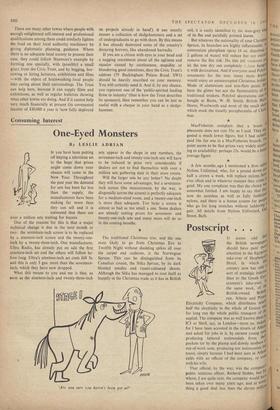be •
Civic Sense
By KENNETH J. ROBINSON THE year 1960 will be remembered as vividly by architects as by game- keepers, remembered as the year when the Civic Trust did as much for city planning as Penguins did for literature. Yet I suppose there are people who are passionately interested in the appear- ance of their towns, but have never heard of the last and the influence it is having on the future Piccadilly Circus--and, as a consequence, on 'Ile future of other important centres. Most Pie, I imagine, will have forgotten exactly the Piccadilly fuss was about. They will be fllinded, if they get hold of the Civic Trust's Pn progress report, The First Three Years, that building designed for the Monico site wtis vaPnsidered 'unworthy' not only because of its .,PPearauce, but also because it was to be built an area that ought to be replanned as a whole. eY will be reminded, too, that if it had not Vlen for the Civic Trust, which collected evidence %Id briefed a QC, there would have been no one Vitt enough resources to put up a successful fight .against the building at the public inquiry.
And what a building! To remind us what nearly happened the Civic Trust has published a full-page picture of the curious, ad-strewn front elevation—covered with four-letter words like RosT ('for your daily wash); mom ('for vigour') and swot) (for an unspecified use). When the artist did this perspective he was unknowingly settling the building's fate (it was this picture that led to the demand for a public inquiry) and also, perhaps, the fate of ill-conceived buildings in other parts of the country. The Minister of Housing's decision that the Circus ought to be redeveloped as a whole, and not bit by bit, started a lot of people thinking about the question of comprehensive development. How, they won- dered, was it possible to make a decent architec- tural job of renewing town centres if all the sites had different owners and could not be bought simultaneously? Appropriately enough it was the Civic Trust which stepped in and provided not the answer, but a number of answers suitable for discussion at a London conference (reported here on July 15).
Since the Piccadilly fuss some people have been more confident about raising objections to the visual horrors going up around them. And some have reinforced their objections with financial help and advice from the Civic Trust which— according to its report—now has 300 local amenity societies on its .register. Although in its report the Trust sums up its direct ways of influencing the appearance of town and country- side, it gives little idea of its indirect influence through local.spcieties. A few of these are merely preservation organisations of the kind that dis- trust anything new, and like to feel (wrongly) that they have a big brother in London to protect them from progress. Others are societies which were formed, like the enterprising two-year-old at Stanmore in Middlesex, not to oppose progres- sive development but to ensure that development is progressive. This week the members of the Stanmore Society have set a splendid example to all similar bodies. After two years of fighting to preserve their trees, their Green Belt and their need for low-density, traffic-free development, they have just made public their own sensible suggestions for the future planning of their town.
The Society's scheme, prepared by a panel of architects and town planners with the co-opera- tion of the Middlesex County Council and Har- row Council, shows how Stanmore could 'main- tain its identity as a village' if its vacant land was properly developed and its 'throttled' shopping centre was bypassed by the main roads which now converge on it from four directions. Most of the vacant land is owned by the Middlesex County Council and there is already a less ambitious local authority bypass proposal, so the scheme is really a timely hint to the Council before it embarks, in 1961, on its quinquennial review of the County Plan. There are many other towns where people with enough enlightened self-interest and professional qualifications among them could similarly lighten the load on their local authority machinery by giving diplomatic planning guidance. Where there is no adequate local society to present their case, they could follow Stanmore's example by forming one specially, with (possibly) a small grant from the Civic Trust, and by begging, bor- rowing or hiring lecturers, exhibitions and films —with the object of brainwashing local people into caring about their surroundings. The Trust can help here, because it can supply films and exhibitions, as well as regular bulletins showing what other towns are doing. And if it cannot help very much financially at present (its covenanted income of £40,000 a year is 'now fully deployed on projects already in hand), it can usually muster a collection of sledgehammers and a set of undergraduates to go with them. By this means it has already destroyed some of the country's decaying horrors, like abandoned barracks.
If you are a citizen with eyes in your head and a nagging resentment about all the ugliness and squalor caused by carelessness, stupidity or blundering good intentions, then the Civic Trust's address (79 Buckingham Palace Road, SW1) should be heavily inscribed on your memory. You will certainly need it. And if, by any chance, you represent one of the 'public-spirited leading firms in industry' (that is how the Trust describes its sponsors), then remember you can be just as useful with a cheque in your hand as a sledge- hammer.



































 Previous page
Previous page